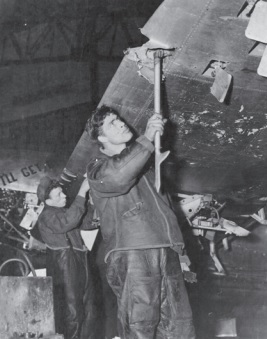Trains were never safe from roaming P-47 Thunderbolts on armed reconnaissance missions. Yet German strategies quickly made strafing them a difficult and risky task
Late in December 1944, as Col. Leo Moon, CO of the 404th FG, climbs away after bombing a German train carrying supplies and reinforcements to the Ardennes front, 3.7cm tracer rounds from carriage-mounted FlaK 43 batteries whiz past P-47D-27-RE 42-27221. Despite weather impeding low-level operations over the Ardennes for the first few days following the start of the German offensive on December 16, according to Jonathan Bernstein in his book P-47 Thunderbolt vs German Flak Defenses, by December 23 the clouds had cleared and the Ninth Air Force’s fighter-bombers started operating from before sunrise to well after sunset, attacking any motor or rail transport headed toward the frontline.
While Thunderbolts went out on armed reconnaissance missions, trains were never secure. But, German strategies swiftly increased the difficulty and risk of strafing them. The Wehrmacht started installing flak guns on wagons for point defense, protecting rolling stock, and transporting supplies to the front. German trains started to come standard-equipped with 2 cm and 3.7 cm guns. Assaulting Thunderbolts typically chose them as one of their first targets after destroying the locomotive. Following that, the remaining rail cars would be strafed.
The Thunderbolt pilots were caught off guard by the mobile flak defense. For instance, when 404th FG CO Col Leo Moon attempted to rocket and strafe two trains on March 12, 1945, he received a harsh lesson:

‘I first saw a train with a number of cars on it and fired my four rockets into it, damaging the locomotive and setting two tank cars on fire. Then I saw a plume of smoke some distance away and fired my guns at the base of it. As I got nearer, I saw that the smoke was coming out of a short tunnel, and a train was protruding from the other end. As I swung around to make an attack on it, I saw a little red ball flash past my wing, and I wondered what it was. I soon found out.
‘I saw some smoke coming up from the middle of the train and thought that was a funny place for a train to be smoking. I suddenly realized it was gun-smoke from a flak car, banging away at me. I had already committed myself, however, and I banked around and sprayed the cars, and pulled up into the overcast. The flak sounded like hail on a tin roof as it hit my plane. My brake was shot out, and there was just a hole in my wing where my pitot tube had been.’
Moon was lucky in that his Thunderbolt only sustained a couple of 2cm damage to the left wing. Without a P-47 bearing down on them, a more skilled gun crew would have likely altered their fire and brought his aircraft down. Within a few days, the 404th FG groundcrews had fixed his damaged aircraft, and it was once again flying.
P-47 Thunderbolt vs German Flak Defenses is published by Osprey Publishing and is available to order here.
Photo by Jim Laurier via Osprey

